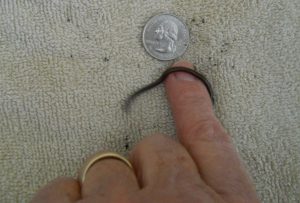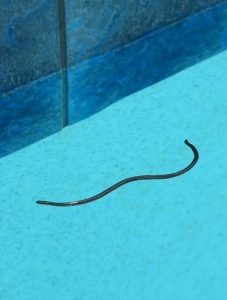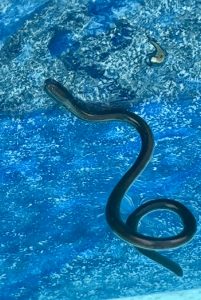
If you’ve followed my blog for a while, you probably know why I started writing. By nature of my job duties and professional expertise, friends and clientele frequently reach out when they come across something odd while outdoors. I’ve been the recipient of random texts and emailed photos of bizarre-looking squishy finds from the beach, unusual plants, and snakes…lots and lots of snakes.

So, when I got photos of a weird little wormlike critter by text last month, I wasn’t the least bit surprised. I’ve actually planned to write about this one for a while, because several people have asked me about it over the years.
The Brahminy blind snake Indotyphlops braminus (also called the “Flowerpot Snake”) is considered a nonnative species due to its origin (Asia & Africa) and movement into natural areas in Florida since the 1970s. Even thought it’s not from here, most biologists do not consider them “invasive,” as they do not meet the criteria of causing ecological or economic harm. In fact, I’ve only heard about people finding them in the Pensacola city limits—particularly East Hill or North Hill neighborhoods (but if you’ve seen one elsewhere, let me know!). Like many introduced insects and amphibians, the snake itself is typically transported through the landscape trade. It is small and can easily bury itself in the soil of a large tree or shrub container. These snakes can also swim, as evidenced by video from my friend of one wriggling around in her pool.

Brahminy blind snakes are members of the Typhlopidae family, which is composed of a cohort of burying snakes that mostly live in underground burrows in the soil. Spending their time in the dark, they have lost the need for vision (like cave-dwelling creatures). They have eye spots that can detect some light, but no detailed visual capability–hence the “blind” in their name. The tiny snakes are solid black (or sometimes purplish gray), about 4-6” long, and truly resemble a worm more than any snake most people are accustomed to seeing. They eat ant and termite eggs and larvae, so many folks would consider their role in the ecosystem rather useful. They are nonvenomous and do not bite, although they will push the slightly pointier posterior end of their bodies onto your skin (this won’t hurt) in a fruitless attempt at self-defense.
Interestingly, Brahminy blind snakes are all female. The species reproduces asexually through a process called parthenogenic thelytoky. The snake’s eggs can divide without a male, and offspring are genetic clones of the mother. Most species with this reproductive adaptation are insects (including the snake’s typical prey, ants), and it is rare among vertebrates. So rare, in fact, that the only vertebrates reproducing via parthenogenesis include several dozen lizards and the Brahminy blind snake. There are plenty of advantages to cutting out the “middle man” so to speak, including faster reproductive cycles and a reduction in energy expenditures related to finding a mate. However, creating genetic clones reduces population diversity, so any disease or innate vulnerability could wipe out relatives without genetic immunity.
 8
8
